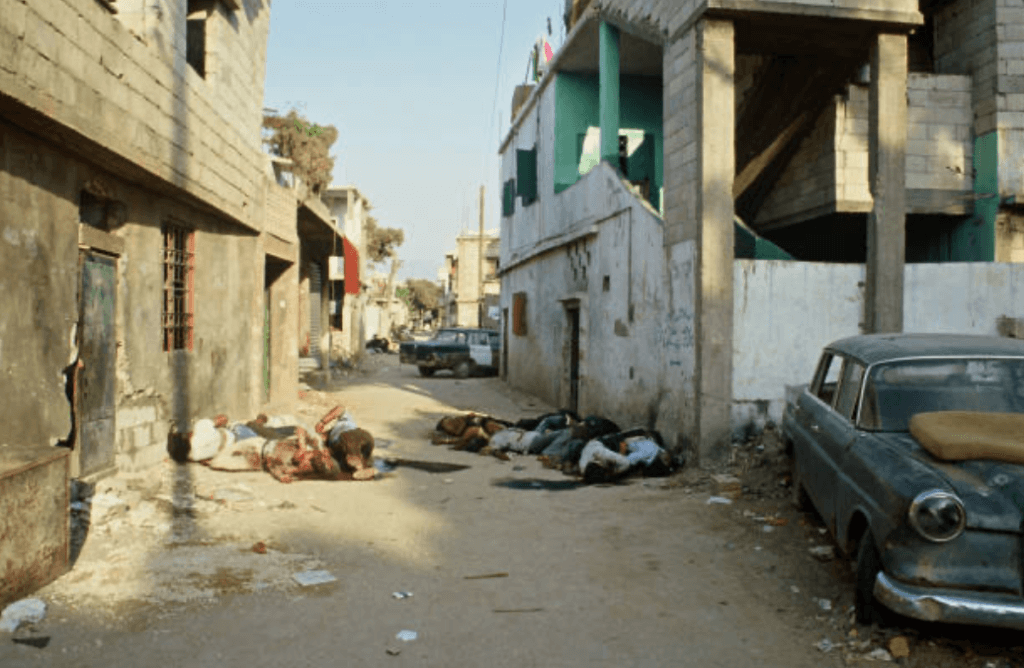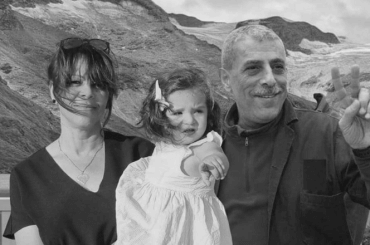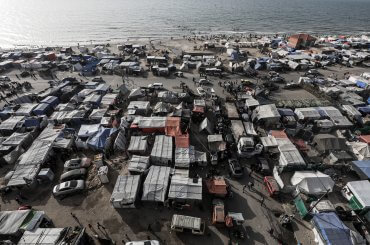There are certain profound events in a nation’s history that leave an indelible mark on all its people. The massacre in two Palestinian refugee camps in Beirut, Sabra and Shatila, on September 16, 1982 stands as one of those events.
Taking place during the course of the Lebanese civil war, Israeli forces shot flares into the night sky, lighting the way for far-right Lebanese militias to carry out the systematic killing of up to 3,500 Palestinian and Lebanese men, women and children. The massacre lasted 48 hours.
Sabra and Shatila signalled the end of an era for the Palestinian resistance movement. An era that grew from the refugee camps in Lebanon and honored Palestinian refugees and their right of return; an era that did not question the value of armed struggle in national liberation; an era that nurtured some of the best of Palestinian cultural and political life; an era that restored Palestinian dignity after the harrowing years that followed the Nakba.
In 1982, the U.S. administration betrayed the written guarantees they had given to the PLO to protect Palestinian civilians in the refugee camps. An article by Palestinian academic Rashid Khalidi in 2017 titled “The United States was responsible for the 1982 massacre of Palestinians in Beirut” studied what guarantees were given by U.S. officials and what they knew at the time. Khalidi also noted in his conclusion that the “ill-considered and morally flawed decisions about the 1982 war that were made by American policy-makers” continue to this day, with the same dangerous repercussions.
Nonetheless, a decade later, the Palestinian leadership agreed to the Oslo Accords, which we now know did immense damage to the Palestinian struggle. Where would the Palestinians stand now if the Oslo Accords had never been ratified, if the First Intifada had continued, if the PLO still inspired unity and stood for all the concepts encompassed in its name?
In 2007, on the 25th anniversary of the Sabra and Shatila massacres, I wrote a commentary that was presented on the Voice of Palestine radio show in Vancouver. Sadly, its words still ring true; we are still waiting for justice, not only for the victims and survivors of Sabra and Shatila but for all Palestinians:
It was September 1982. The summer had been brutal, the Israeli invasion of Lebanon being the issue we lived with, woke up to, and went to bed with. There was no internet, and our days were consumed with obtaining even the smallest slivers of news about the Palestinian and Lebanese casualties of the war, that numbered in the tens of thousands. We organized rallies, raised money for humanitarian aid, but none of it could erase or even reduce the emotional turmoil we constantly faced.
And then, as we all debated how and why the PLO forces left Beirut with supposed U.S. guarantees for the safety of civilians, we began to receive the flickering images on our TV screens of piled up and disfigured bodies from Sabra and Shatila. At first, the full horror of it was not immediately realized, and again, it took some time before all the details emerged. At least 3000 civilians (bodies were dumped in mass graves so figures are at best conservative) butchered and mutilated by Lebanese fascist forces with the full support of the occupying Israeli army in manners almost too gruesome to think about. And all of this with American guarantees for civilian safety.
We were like people in shock, numbly going ahead with plans for large protests but knowing at some deeper level, that the tragedy here would take a long time to process.
Many events happened in the aftermath but none brought the smallest amount of justice to the Sabra and Shatila victims. Ariel Sharon was found complicit even by Israeli institutions, but then returned as prime minister some years later. The victims tried to receive some modicum of accountability with their lawsuit in Belgian courts, which was then squashed by pressure from U.S. and other governments. Once again, the massacre of Palestinians was an inconvenient reality, and the memory of it even more inconvenient.”
Perhaps the new normalization/weapons agreements that have just been signed at the White House, one day before the Sabra and Shatila anniversary, will be looked back on by future analysts as marking the end of another era. The era of U.S. hegemony, destruction, and disregard for the lives and livelihood of the Palestinian and Arab peoples. And only then will the scars of the Sabra and Shatila massacre truly begin to heal.



Thank you Marion Kawas!!
Also;
To be brief:
In 1982, in accordance with the master plan first proposed by Ben-Gurion, et al in 1948, “Israel” launched an unprovoked (i.e., the PLO had scrupulously adhered to the 1981 cease-fire negotiated by the Reagan administration) invasion of Lebanon, the objective of which was to destroy the morale of Palestinians in the occupied territories by obliterating the PLO, gaining control of Lebanon’s Litani River (to divert its waters into northern Israel) and to install a “friendly” Phalangist (i.e., fascist) government in Beirut. As the U.S. Senate Foreign Relations Committee declared at the time, well over 20,000 Lebanese nationals and Palestinian refugees were killed and half a million turned into refugees by “Israel” during its invasion.
On September 16th, as orchestrated by then “Israel’s” Defense Minister, Ariel Sharon, at least 3,000 Palestinian children, women and old men were massacred in Lebanon’s Sabra and Shatila refugee camps by “Israel’s” Phalangist allies while the occupation forces looked on. With Sharon’s full approval, “Israel’s” soldiers provided the Phalangists with night time illumination and bulldozers to dispose of the bodies, served them tea, cookies and cokes during breaks from their murderous rampage and prevented the Palestinians from escaping.
Sharon paid no meaningful price for his monstrous crime even though “Israel’s” Kahan Commission Report found that he “bears personal responsibility” for the massacres at Sabra and Shatila (only one of many documented unspeakable atrocities Sharon instigated and/or directly participated in during his “career.”)
From 2018, a New York Review of Books Daily article, “Sabra and Shatila: New Revelations”:
https://www.nybooks.com/daily/2018/09/17/sabra-and-shatila-new-revelations/
The militia fighters congregated at the Beirut airport, a major Israeli staging point; from there, they were ushered through Israeli lines into the camps, which were surrounded by Israeli forces. Under the command of Phalange leader Elie Hobeika, these men raped, killed, and dismembered hundreds of women, children, and elderly men while Israeli flares illuminated the camps’ narrow, dark alleyways. Sharon, meanwhile, briefed his cabinet colleagues on September 16 about the Phalange movements, stressing, according to cabinet minutes, that “the results will speak for themselves… let us have the number of days necessary for destroying the terrorists” (I: 287). This insistence on the presence of “terrorists” belied the actuality of who had remained after the PLO’s evacuation, yet it fit with Israel’s rhetorical strategy of deliberately blurring distinctions between Palestinian civilians and armed fighters.